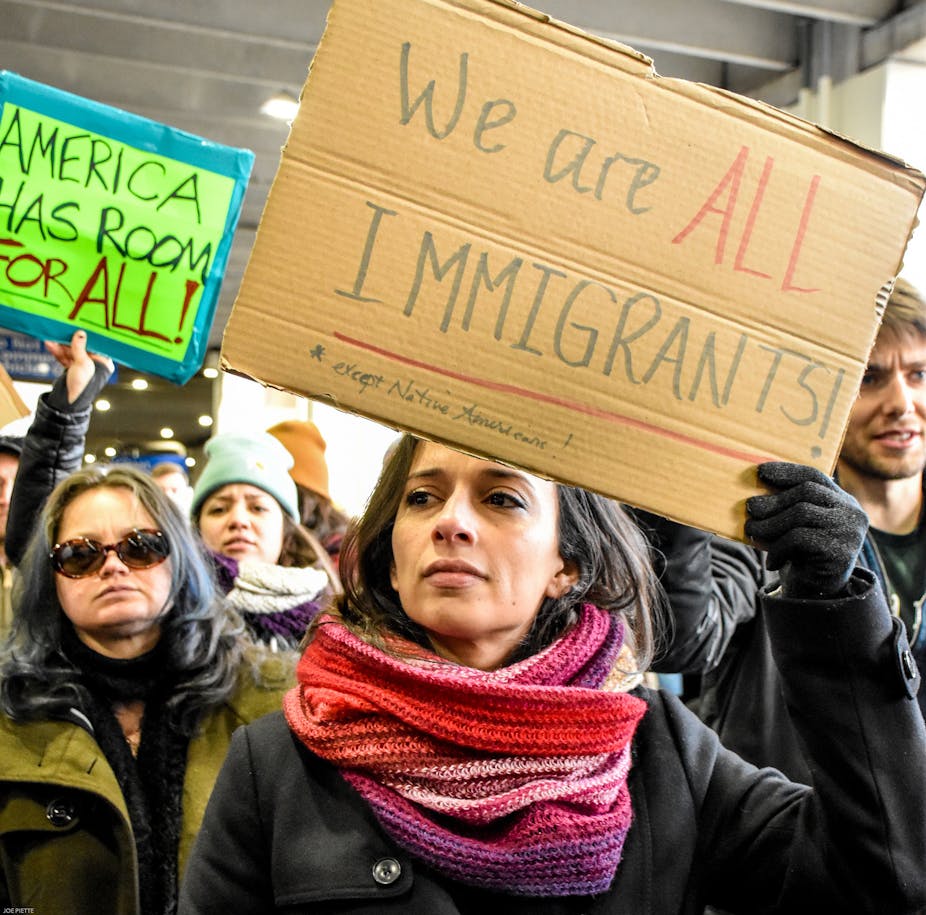How Trump’s travel ban differs from Obama’s visa restrictions

Donald Trump’s executive order on immigration, issued on January 27 2017, indefinitely bars Syrian refugees from entering the US, suspends the admission of all refugees for 120 days and blocks citizens of seven Muslim-majority countries – Iran, Iraq, Libya, Somalia, Sudan, Syria and Yemen – from entering the country for 90 days.
Introduced as a policy to “protect its citizens from foreign nationals who intend to commit terrorist attacks in the United States”, the order has provoked a storm of protest worldwide. Foreign governments remindedthe US president of his obligations under international human rights law, such as the Geneva Refugee Convention, of which the US is a signatory.
Visitors, students, scientists, family members, even permanent residents with green cards have been stopped at airports around the world, plunging customs and arrival zones into chaos. Former president, Barack Obama, publicly spoke out against the immigration ban, and acting attorney general Sally Yates was fired after having instructed officials not to enforce the new order.
Obama’s visa restrictions
Deflecting the criticism, Trump now points a finger at Obama. Trump has compared his new policy with an alleged visa ban for refugees from Iraq for six months, issued in 2011 under his predecessor. More recently, legislation that imposes travel restrictions on travellers from the seven countries had already passed congress under the Obama administration.

The suggestively labelled “Visa Waiver Program Improvement and Terrorist Travel Prevention Act” of December 2015 complicated the visa application process for citizens of Iran, Iraq, Sudan or Syria. It also made it more difficult for anyone who had visited any of these countries on or after March 1 2011 to get a visa, as I had to find out myself after I was effectively barred from attending a conference in the US as an EU academic because I had previously visited Iran.
The restrictions aimed to prevent people with ties to countries thought to pose a terror threat from using the Electronic System for Travel Authorisation to travel to the US with minimal screening.
That act erected discriminatory barriers for access to the US for scholars, people with dual nationality, or tourists. And while the December 2015 act was not based on an executive order issued by the president, Obama could have vetoed that congressional piece of legislation, but didn’t. Somalia, Libya, and Yemen were added in February 2016 as “countries of concern” by the Department of Homeland Security, and it was this list of seven countries referred to in Trump’s executive order.
The arbitrary classification of these seven countries as “terror threats” stays the same. Saudi Arabia, Egypt or other countries with links to the 9/11 perpetrators are not on the list, rendering Trump’s evocation of the September 11 attacks in the executive order sketchy at best. Neither are countries like Turkey, in which the Trump Organisation has done business.
Trump’s new order, however, differs from the December 2015 law in its scale. Under the new rules, the US is detaining people that have already undergone lengthy vetting procedures. Imposing a blanket travel ban against entire nationalities not only violates commitments the US made under international law and is controversial constitutionally, it is also imprudent policy. Jihadist groups are already celebrating the new travel ban as a propaganda success, bolstering their claim that the US is waging a war on Islam – despite Trump’s attempts to underline that the travel ban is “not about religion”.
Unsealing the Iran deal?
With regard to Iran, the new policy has particular political implications. The US committed itself to “refrain from any policy specifically intended to directly and adversely affect the normalisation of trade and economic relations with Iran” as part of a nuclear agreement with Iran reached in July 2015. The December 2015 changes to the US visa programme had already been criticised as contravening the spirit of this agreement.
With Iranian academics, businessmen, and family members now stranded at airports and barred entry to the US, the US now is seen as taking steps that undermine pledges made in the nuclear deal. It has strengthened Iranian critiques and hardened suspicions about the trustworthiness of US commitments. Iran has already announced that it will ban US visitors in retaliation.
So besides the carefully rehearsed security argument, the new travel ban is also a policy that undermines the agreement made with Iran – and is therefore in line with Trump’s criticism of “one of the worst deals” he has ever seen negotiated. As the order was drafted without inter-agency consultations with Homeland Security, the Justice, State, or Defense departments, it is not entirely clear whether the “incompetence mitigates the malevolence” or whether the political signals are deliberate.


Comments
Post a Comment